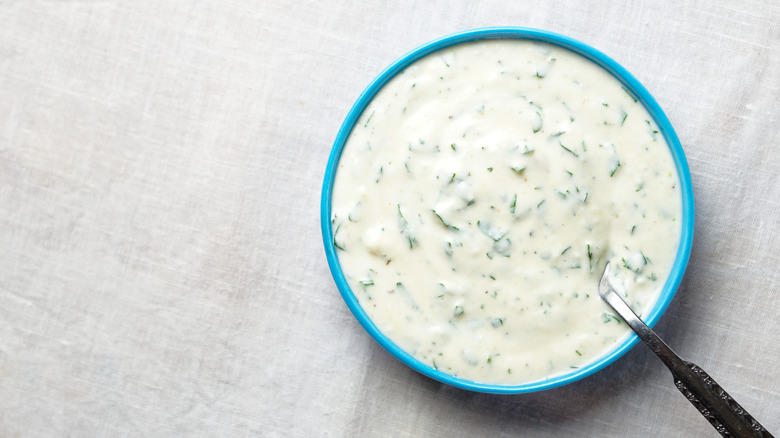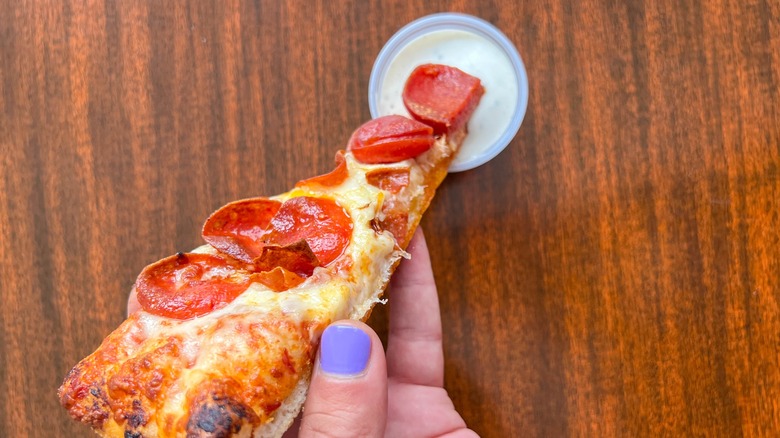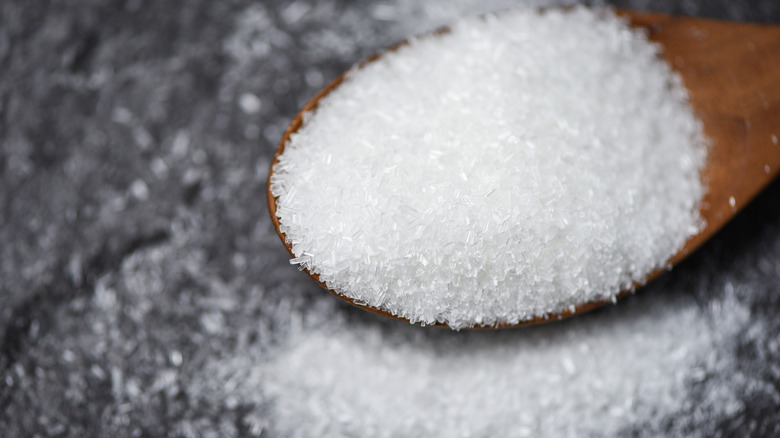Give Ranch Dressing An Umami Boost With A Sprinkle Of MSG
Ranch dressing is about as American as baseball and apple pie, but this now-ubiquitous condiment isn't as old as you may think. Created in the 1950s by a man named Steven Henson and sold under the brand name Hidden Valley Ranch, the dressing — originally available only as a seasoning packet — is a relative newcomer to the American pantry and dinner table. But since its introduction at a steakhouse, ranch dressing has amassed a legion of devotees. The dressing's light tang and balanced blend of seasonings go with pretty much everything. You can pour it over salads, use it as a dip for chips or raw veggies, drizzle it on pizza, stir it into chili, or tuck it inside a casserole to incorporate some extra zip.
Over the years, ranch dressing has continued to evolve, with food manufacturers and home cooks tinkering with the basic ranch recipe of buttermilk, mayonnaise, herbs, and spices. But to enhance this classic condiment doesn't require a dramatic reformulation; all you need to elevate your ranch dressing is one well-known, yet underutilized ingredient: monosodium glutamate, more commonly known as MSG.
MSG takes ranch dressing to new heights by adding depth
Ranch dressing is adored by millions, which is why it still holds the title of the most popular salad dressing in the United States. It's creamy, cool, and pleasantly sour, but it does arguably lack one important element: umami. The enigmatic fifth taste (along with sour, salty, sweet, and bitter), umami adds a layer of savory depth to all types of foods. Tomatoes, mushrooms, anchovies, kelp, and many aged cheeses are just a few of the many naturally umami-rich foods. That being said, you don't need to blend anchovies or Manchego cheese into your ranch dressing to infuse it with umami. In most cases, you're better off adding a few dashes of pure MSG.
When added to ranch dressing, the seasoning contributes an almost imperceptible richness that's neither salty nor meaty. Instead, a bit of MSG reinforces ordinary ranch dressing with a savory backbone that makes this impeccable ingredient even tastier. When it comes to adding MSG, start by sprinkling it in little by little, as you would salt or another potent seasoning, and adjust to taste. This ensures you'll achieve a harmonious balance of flavors that fits your taste preferences.
What is MSG, and is it safe?
Monosodium glutamate is a common additive in the food and beverage industry used to add a savory flavor to everything from chips and sauces to ramen noodles and deli meats. Although it may seem like a product of modern food science, the idea of a glutamate-based seasoning has existed for millennia, dating back to the fermented fish sauces of ancient Rome. However, despite it being used in different culinary capacities for hundreds of years, it was only in the past century that Kikunae Ikeda, a chemistry professor at the University of Tokyo, isolated glutamate and combined it with sodium to make the MSG we know today.
MSG has been commercially produced since 1908; nowadays, like any other spice, MSG is available online and in supermarkets around the country. For a time, the ingredient was the target of safety concerns and scrutiny – much of which was unwarranted and due largely to racism and xenophobia associated with Asian, specifically Chinese, cuisine. Today, the U.S. Food and Drug Administration considers MSG to be Generally Recognized as Safe (GRAS), putting it in the same category as canola oil, sugar, and spices such as black pepper. Perfectly safe and perfect for adding a new level of savory depth, MSG is the flavor enhancer your ranch dressing has been hungry for.


